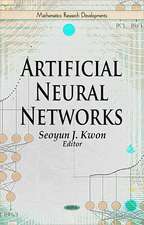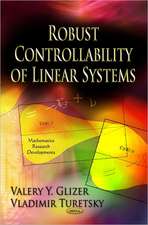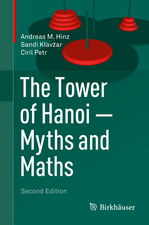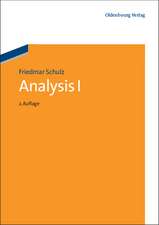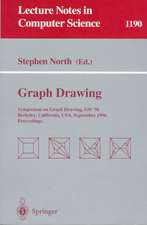The Tower of Hanoi – Myths and Maths
Autor Andreas M. Hinz, Sandi Klavžar, Uroš Milutinović, Ciril Petren Limba Engleză Hardback – 31 ian 2013
Numerous captivating integer sequences arise along the way, but also many open questions impose themselves. Central among these is the famed Frame-Stewart conjecture. Despite many attempts to decide it and large-scale numerical experiments supporting its truth, it remains unsettled after more than 70 years and thus demonstrates the timeliness of the topic.
Enriched with elaborate illustrations, connections to other puzzles and challenges for the reader in the form of (solved) exercises as well as problems for further exploration, this book is enjoyable reading for students, educators, game enthusiasts and researchers alike.
| Toate formatele și edițiile | Preț | Express |
|---|---|---|
| Paperback (1) | 567.19 lei 22-36 zile | |
| Springer – iul 2015 | 567.19 lei 22-36 zile | |
| Hardback (1) | 624.26 lei 22-36 zile | |
| Springer – 31 ian 2013 | 624.26 lei 22-36 zile |
Preț: 624.26 lei
Nou
Puncte Express: 936
Preț estimativ în valută:
119.45€ • 125.03$ • 99.42£
119.45€ • 125.03$ • 99.42£
Carte disponibilă
Livrare economică 10-24 martie
Preluare comenzi: 021 569.72.76
Specificații
ISBN-13: 9783034802369
ISBN-10: 3034802366
Pagini: 352
Ilustrații: XV, 335 p.
Dimensiuni: 155 x 235 x 25 mm
Greutate: 6.51 kg
Ediția:2013
Editura: Springer
Colecția Birkhäuser
Locul publicării:Basel, Switzerland
ISBN-10: 3034802366
Pagini: 352
Ilustrații: XV, 335 p.
Dimensiuni: 155 x 235 x 25 mm
Greutate: 6.51 kg
Ediția:2013
Editura: Springer
Colecția Birkhäuser
Locul publicării:Basel, Switzerland
Public țintă
Upper undergraduateCuprins
Foreword by Ian Stewart.- Preface.- 0 The Beginning of the World.- 1 The Chinese Rings.- 2 The Classical Tower of Hanoi.- 3 Lucas’s Second Problem.- 4 Sierpinski Graphs.- 5 The Tower of Hanoi with More Pegs.- 6 Variations of the Puzzle.- 7 The Tower of London.- 8 Tower of Hanoi Variants with Oriented Disc Moves.- 9 The End of the World.- A Hints and Solutions to Exercises.- Glossary.- Bibliography.- Name Index.- Subject Index.- Symbol Index.
Recenzii
“The Tower of Hanoi isn’t just a recreational problem, it is also a substantial area worthy of study, and this book does this area full justice. … I haven’t enjoyed reading a ‘popular mathematics’ book as much for quite some time, and I don’t hesitate to recommend this book to students, professional research mathematicians, teachers, and to readers of popular mathematics who enjoy more technical expository detail.” (Chris Sangwin, The Mathematical Intelligencer, Vol. 37, 2015)
“This book takes the reader on an enjoyable adventure into the Tower of Hanoi puzzle (TH) and various related puzzles and objects. … The style of presentation is entertaining, at times humorous, and very thorough. The exercises ending each chapter are an essential part of the explication providing some definitions … and some proofs of the theorems or statements in the main text. … As such, the book will be an enjoyable read for any recreational mathematician … .” (Andrew Percy, zbMATH, Vol. 1285, 2014)
“This research monograph focuses on a large family of problems connected to the classic puzzle of the Tower of Hanoi. … The authors explain all the combinatorial concepts they use, so the book is completely accessible to an advanced undergraduate student. … Summing Up: Recommended. Comprehensive mathematics collections, upper-division undergraduates through researchers/faculty.” (M. Bona, Choice, Vol. 51 (3), November, 2013)
“The Tower of Hanoi is an example of a problem that is easy to state and understand, yet a thorough mathematical analysis of the problem and its extensions is lengthy enough to make a book. … there is enough implied mathematics in the action to make it interesting to professional mathematicians. … It was surprising to learn that the ‘simple’ problem of the Tower of Hanoi … could be the subject of a full semester special topics course in advanced mathematics.” (Charles Ashbacher, MAA Reviews, May, 2013)
“Gives an introduction to the problem and the history of the TH puzzle and other related puzzles, but it also introduces definitions and properties of graphs that are used in solving these problems. … Thus if you love puzzles, and more in particular the mathematics behind it, this is a book for you. … Also if you are looking for a lifelasting occupation, then you may find here a list of open problems that will keep you busy for a while.” (A. Bultheel, The European Mathematical Society, February, 2013)
“This book takes the reader on an enjoyable adventure into the Tower of Hanoi puzzle (TH) and various related puzzles and objects. … The style of presentation is entertaining, at times humorous, and very thorough. The exercises ending each chapter are an essential part of the explication providing some definitions … and some proofs of the theorems or statements in the main text. … As such, the book will be an enjoyable read for any recreational mathematician … .” (Andrew Percy, zbMATH, Vol. 1285, 2014)
“This research monograph focuses on a large family of problems connected to the classic puzzle of the Tower of Hanoi. … The authors explain all the combinatorial concepts they use, so the book is completely accessible to an advanced undergraduate student. … Summing Up: Recommended. Comprehensive mathematics collections, upper-division undergraduates through researchers/faculty.” (M. Bona, Choice, Vol. 51 (3), November, 2013)
“The Tower of Hanoi is an example of a problem that is easy to state and understand, yet a thorough mathematical analysis of the problem and its extensions is lengthy enough to make a book. … there is enough implied mathematics in the action to make it interesting to professional mathematicians. … It was surprising to learn that the ‘simple’ problem of the Tower of Hanoi … could be the subject of a full semester special topics course in advanced mathematics.” (Charles Ashbacher, MAA Reviews, May, 2013)
“Gives an introduction to the problem and the history of the TH puzzle and other related puzzles, but it also introduces definitions and properties of graphs that are used in solving these problems. … Thus if you love puzzles, and more in particular the mathematics behind it, this is a book for you. … Also if you are looking for a lifelasting occupation, then you may find here a list of open problems that will keep you busy for a while.” (A. Bultheel, The European Mathematical Society, February, 2013)
Notă biografică
Andreas M. Hinz is Professor at the Department of Mathematics, University of Munich (LMU), Germany. He has worked at the University of Geneva (Switzerland), King's College London (England), the Technical University of Munich (Germany), and the Open University in Hagen (Germany). His main fields of research are real analysis, the history of science, mathematical modeling, and discrete mathematics.
Sandi Klavžar is Professor at the Faculty of Mathematics and Physics, University of Ljubljana, Slovenia, and at the Department of Mathematics and Computer Science, University of Maribor, Slovenia. He is an author of three books on graph theory and an editorial board member of numerous journals including Discrete Applied Mathematics, European Journal of Combinatorics, and MATCH Communications in Mathematical and in Computer Chemistry.
Uroš Milutinović is Professor at the Faculty of Natural Sciences and Mathematics, University of Maribor, Slovenia. His main fields of research are topology and discrete mathematics.
Ciril Petr is a researcher at the Faculty of Natural Sciences and Mathematics, University of Maribor, Slovenia.
Sandi Klavžar is Professor at the Faculty of Mathematics and Physics, University of Ljubljana, Slovenia, and at the Department of Mathematics and Computer Science, University of Maribor, Slovenia. He is an author of three books on graph theory and an editorial board member of numerous journals including Discrete Applied Mathematics, European Journal of Combinatorics, and MATCH Communications in Mathematical and in Computer Chemistry.
Uroš Milutinović is Professor at the Faculty of Natural Sciences and Mathematics, University of Maribor, Slovenia. His main fields of research are topology and discrete mathematics.
Ciril Petr is a researcher at the Faculty of Natural Sciences and Mathematics, University of Maribor, Slovenia.
Textul de pe ultima copertă
This is the first comprehensive monograph on the mathematical theory of the solitaire game “The Tower of Hanoi” which was invented in the 19th century by the French number theorist Édouard Lucas. The book comprises a survey of the historical development from the game’s predecessors up to recent research in mathematics and applications in computer science and psychology. Apart from long-standing myths it contains a thorough, largely self-contained presentation of the essential mathematical facts with complete proofs, including also unpublished material. The main objects of research today are the so-called Hanoi graphs and the related Sierpiński graphs. Acknowledging the great popularity of the topic in computer science, algorithms and their correctness proofs form an essential part of the book. In view of the most important practical applications of the Tower of Hanoi and its variants, namely in physics, network theory, and cognitive (neuro)psychology, other related structures and puzzles like, e.g., the “Tower of London”, are addressed.
Numerous captivating integer sequences arise along the way, but also many open questions impose themselves. Central among these is the famed Frame-Stewart conjecture. Despite many attempts to decide it and large-scale numerical experiments supporting its truth, it remains unsettled after more than 70 years and thus demonstrates the timeliness of the topic.
Enriched with elaborate illustrations, connections to other puzzles and challenges for the reader in the form of (solved) exercises as well as problems for further exploration, this book is enjoyable reading for students, educators, game enthusiasts and researchers alike.
Numerous captivating integer sequences arise along the way, but also many open questions impose themselves. Central among these is the famed Frame-Stewart conjecture. Despite many attempts to decide it and large-scale numerical experiments supporting its truth, it remains unsettled after more than 70 years and thus demonstrates the timeliness of the topic.
Enriched with elaborate illustrations, connections to other puzzles and challenges for the reader in the form of (solved) exercises as well as problems for further exploration, this book is enjoyable reading for students, educators, game enthusiasts and researchers alike.
Caracteristici
The first comprehensive monograph on the topic
Thorough presentation of the historical development
Numerous attractive figures and original photos
Connections to various mathematical fields and applications to fields like computer science and psychology
Exercises with hints and solutions
No special knowledge of advanced mathematics assumed from the reader
Includes supplementary material: sn.pub/extras
Thorough presentation of the historical development
Numerous attractive figures and original photos
Connections to various mathematical fields and applications to fields like computer science and psychology
Exercises with hints and solutions
No special knowledge of advanced mathematics assumed from the reader
Includes supplementary material: sn.pub/extras

